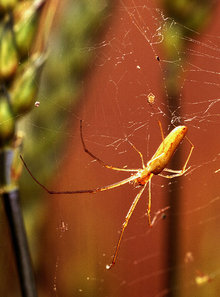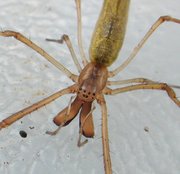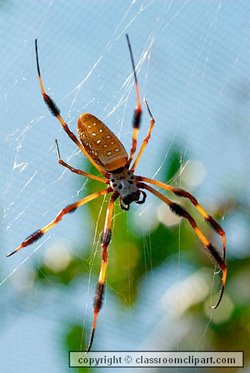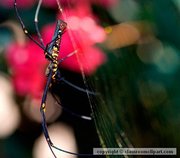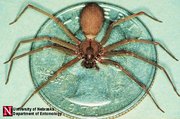Spider
|
|
Spiders are invertebrate animals that produce silk, have eight legs and no wings. More precisely, a spider is any member of the arachnid order Araneae, an order divided into three sub-orders in newer systems: the Mygalomorphae (the primitive spiders), the Araneomorphae (the modern spiders) and the Mesothelae, which contains the Family Liphistiidae, rarely seen burrowing spiders from Asia. The study of spiders is known as arachnology, although it is often grouped under the more general area of entomology.
Many spiders hunt by building webs to trap insects. These webs are made of spider silk, a thin, strong protein strand extruded by the spider from spinnerets on the end of the abdomen. All spiders produce silk, although not all use it to spin elaborate traps. Silk can be used to aid in climbing, forming smooth walls for burrows, cocooning prey, and for many other applications.
| Contents |
|
5.1 Tangleweb spiders |
Morphology and development
Spiders, unlike insects, have only two body segments instead of three; a fused head and thorax (called a cephalothorax or prosoma) and an abdomen (called the opisthosoma), supported by a hard exoskeleton composed of mainly of chitin. Spiders also have eight legs (insects have six), no antennae, and their eyes are single lenses rather than compound eyes. Additionally spiders have pedipalps (or just palps), which are two appendages next to their mouths that aid in manipulating food.
Respiration and circulation
Spiders have an open circulatory system, meaning they don't have true blood or veins for it to travel in. Rather their bodies are filled with haemolymph, which is pumped through arteries by a heart into spaces called sinuses surrounding their organs.
Spiders have developed several different respiratory anatomies, based either on book lungs, a tracheal system, or both. Primitive mygalomorph spiders generally have only a pair of book lungs filled with haemolymph, where openings on the ventral surface of the abdomen allows air to enter and diffuse oxygen. Modern araneomorph spiders often have a single book lung in addition to spiracles which deliver air into the tracheae, where oxygen is then diffused into the haemolymph. In the tracheal system oxygen interchange is much more efficient, enabling cursorial hunting (hunting involving rapid pursuit) and other advanced characteristics.
Archindae_characters.jpg
(1) four pairs of legs
(2) cephalothorax
(3) opisthosoma
Vision
Spiders usually have eight eyes in various arrangements, a fact which is used to taxonomically classifiy different species. Sometimes one pair of eyes is better developed than the rest, or there are only six pair, or no eyes at all. Several families of hunting spiders have developed good to excellent vision, such as wolf spiders and jumping spiders. However most spiders that lurk on flowers, webs and other fixed locations waiting for prey have very poor eyesight, but possess extreme sensitivity to vibrations for hunting.
Defense
Some primitive spiders, like the tarantula, have a patch of urticating hairs on their abdomens for defense, which are generally absent on modern spiders.
Life cycle
The spider life cycle progresses through three stages: the embryonic, the larval, and the nympho-imaginal (Foelix, 1996).
Between the time an egg is fertilized and the spider begins to take the shape of a spider is referred to as the embryonic stage (Foelix, 1996). As the spider begins to look more like a spider it enters the larval stage (Foelix, 1996). It enters the larval stage as a prelarva and, through subsequent molts, it reaches its larval form, a spider-looking, non self-sufficient animal feeding off its yolk supply (Foelix, 1996). After a few more molts, body structures become differentiated; all organ systems are complete and the animal begins to hunt on its own; it has reached the nympho-imaginal stage (Foelix, 1996). This stage is differentiated by two sub-stages: the nymph, or juvenile stage and the imago, or adult stage (Foelix, 1996). A spider does not transition from the nymph to the imago until it has become sexually mature (Foelix, 1996). Once a spider has reached the imago stage, it will remain here until its death.
Reproduction
Spiders reproduce by eggs laid in silk bundles called egg sacs.
Spiders often use elaborate mating rituals (especially in the visually advanced jumping spiders) to allow the male to approach close enough to inseminate the female without triggering a predatory response. Assuming that the approach signals are exchanged correctly, the male spider must make a timely departure after mating to escape before the female's normal predatory instincts come back into operation.
Unusually, sperm transmission is an indirect process. When a male is ready to mate, he will spin a web pad onto which the contents of the abdominal reproductive organs are discharged. He then dips his palps (also known as 'palpi'), the small, leg-like appendages on the front of his cephalothorax, into the sperm, absorbing it. Mature male spiders characteristically have swollen bulbs on the end of their palps for this purpose, and this is a useful way to identify the sex of a spider in the field. With his palps thus 'charged' he then goes off in search of a female. The act of copulation occurs when the male inserts one or both palps into the female's genital opening, known as the epigyne. He transfers his sperm into the female by contracting his palps.
Very unusual behaviour is seen in spiders of the genus Tidarren, as the male amputates one of his palps before maturation and enters his adult life with one palp only. The palpi constitute 20% of its body mass, and since this weight greatly impedes its movement, the spider detaches one of the two to gain mobility. In the Yemani species Tidarren argo, the remaining palp is then torn off by the female. The separated palp remains attached to the female's epigynum for about four hours and apparently continues to function independently. In the meantime the female feeds on the palpless male. (Journal of Zoology (2001), 254:449-459 Cambridge University Press)
Do female spiders eat their mates?
It is often said that the male (usually significantly smaller than the female, down to 1% of her size for Tidarren sisyphoides) is likely to be killed by the female after the coupling, or sometimes before intercourse has occurred. This supposed propensity is what gave the black widow spider (Latrodectus mactans) its name, but it is the Australian red-backed spider (Latrodectus hasselti) that seems to require the sacrifice of the male.
The male Latrodectus hasselti actually dies after it inserts its second palpus in the female genital opening even if the female does not eat it. The three species of North American black widows do not seem to require the death of the male (although it may occur) and males can sometimes live in the web of a female for a while without being harmed.
However, despite these examples, and many other similar reports, the arresting story of the 'sacrificial male' has become perhaps somewhat greater than the truth. Mating of spiders is not invariably followed by cannibalism. Rainer F. Foelix, (1982), says "The supposed aggressiveness of the female spider towards the male is largely a myth... only in some exceptional cases does the male fall victim to the female.". Michael Roberts (1995) says "It is rare for a fit male to be eaten by the female..."
Possibly the general difficulty of observing spiders mating, and the wide variation in their mating habits, has allowed this idea to become so well-established. Undoubtedly there are occasions (as in Tidarren argo) when the female does eat the successful male suitor, and there has been much speculation on why this sacrifice of male mates might occur. One theory is that once the male has mated, if he is unlikely to mate again then further extension of his life serves no evolutionary purpose, while the sacrifice of the male may help increase egg production through increased nutrition for the female. Having more offspring would give the male an advantage of having his genes passed on over other males that were not eaten. This would be consistent with the hypothesis (Roberts, 1995) that old or unfit males get eaten, whilst younger and fitter ones may survive to mate again.
Ecology
Spider.jpg
Spiders have a great range of variation and lifestyle, although all are predatory.
While spiders are generalist predators, in actuality their different methods of prey capture often limits the type of prey taken. Thus web-building spiders rarely capture caterpillars and crab spiders that ambush prey in flowers capture more bees, butterflies and some flies than other insects. Groups of families that tend to take certain types of prey because of their prey capture methods are often called guilds. A few spiders are more specialized in their prey capture. Dysdera captures and eats sowbugs, pillbugs and beetles, while pirate spiders eat only other spiders. Bolas spiders in the family Araneidae use sex pheromone analogs to capture only the males of certain moth species! Despite their generally broad prey ranges spiders are one of the most important links in the regulation of the populations of insects. Every day on a meadow they devour over 10 g/m² of insects and other arthropods.
Predatory techniques
There are many families of spiders, and the ways that they catch prey are diverse. But whether they catch insects, fish, small mammals, small birds, or some other small form of life, as soon as a spider makes contact with its prey it will attempt to bite.
Spiders bite their prey, and occasionally animals that cause them pain or threaten them, to do two things. First, they inflict mechanical damage, which, in the case of a spider that is as large or larger than its prey, can be severe. Second, they can choose to inject venom through their hollow fangs. Many genera, such as the widow spiders, inject neurotoxins that can spread through the prey's entire body and interfere with vital body functions. Other genera inject venom that operates to produce tissue damage at the site of the bite. Genera such as that of the brown recluse spider produce a necrotoxin. The necrotoxin is injected into prey where it causes the degradation of cell membranes. In the larger victims that do not die from these attacks, painful lesions over a fairly wide area of the body can remain active for fairly long periods of time.
Digestion is carried out internally and externally. The spiders secrete digestive fluids into their prey from a series of ducts perforating their jaws. These digestive fluids dissolve the prey's internal tissues. Then, the spider feeds by sucking the partially digested fluids out. Spiders consume only liquid foods. Many spiders will store prey temporarily while this process of external digestion is going on. Web weaving spiders that have made a shroud of silk to quiet their envenomed prey's death struggles will generally leave them in these shrouds and then consume them at their leisure.
Spider webs and prey capture
Main article: Spider web
Some spiders spin funnel-shaped webs, others make irregular webs, and still others make the spiral "orb" webs which are most commonly associated with the order.
The spider, after spinning its web, will then wait (often, but not always, at the center of the web) for a prey animal to become trapped. They sense the impact and struggle of a prey animal by vibrations transmitted along the web lines.
Other species of spiders do not use webs for capturing prey directly, instead pouncing from concealment (e.g. Trapdoor spiders) or running them down in open chase (e.g. Wolf spiders). Spiders do not usually adhere to their own webs. However, they are not immune to their own glue. Some of the strands of the web are sticky, and others are not. The spiders have to be careful to only climb on the non-sticky strands.
Types of spiders and the severity of their bites
Over 37,000 species of spiders have been identified but, because of their great ability for hiding, it is believed there are nearer 200,000 species. Almost all species are venomous, but only 30 species are known to be deadly dangerous.
Key to bite severity:
- Extremely dangerous: Bite (assuming successful envenomation) is likely to cause death in a healthy adult without emergency medical treatment.
- Very dangerous: Bite may cause death in childern, the elderly, the infirm without prompt medical treatment; and/or may cause debilitating injury. Prompt medical attention is required.
- Dangerous: Bite unlikely to cause death/no known deaths reported; bite may cause significant local or systematic reaction. Medical attention is generally required to limit scope of symptoms.
- Painful bites: Venom may inflict localized pain (similar to a bee sting) but does not have any dangerous or long-term side effects. Medical attention generally not required.
- Not dangerous: Spider is unable to puncture human skin, and/or venom does not cause any significant reaction in humans.
- No venom: This species does not produce venom. [Note: All true spiders except the Family called Hackled_orbweavers produce venom; some Arachnids often confused with spiders. such as the harvestman, do not.]
Tangleweb spiders
- Black widow spider (very dangerous)
- Red-back spider (very dangerous)
- American house spider (not dangerous)
Orb web spiders (Araneidae)
- St Andrew's Cross spider (also known as an argiope) (not dangerous)
- Long-jawed orb weaver Tetragnathidae (see above) (not dangerous)
- Cyclosa conica (not dangerous)
- Golden silk spider (see above) (not dangerous)
- European garden spider (not dangerous)
- Australian Garden Orb Weaver Spider (not dangerous)
- Jewel Spider (not dangerous)
Other forms of webs
- Sydney funnel-web spider (extremely dangerous)
- Bowl and doily spiders (not dangerous)
- Hobo spider (dangerous)
- Grass spiders (not dangerous)
- Filmy dome spider (not dangerous)
- Hackled orbweavers (no venom)
Spiders that live on flowers
- Crab spiders (Thomisidae) (not dangerous)
Hunting spiders
- Brazilian Wandering Spider (extremely dangerous)
- Brown recluse spider (very dangerous)
- Huntsman spiders (painful bites)
- Jumping spiders (not dangerous)
- Lynx spiders (not dangerous)
- Nursery web spiders (not dangerous)
- Spitting spiders (not dangerous)
- Tarantulas (not dangerous)
- Wolf spiders (Lycosidae) (not dangerous)
- Yellow sac spider (painful bites)
Spiders which ambush their prey
- Six-eyed sand spider (exteremely dangerous)
- Trapdoor spiders (painful bites)
Others
- Camel spider, very well-known as having many urban legends (painful bites according to most legends)
- Kimura-gumo ((Heptathela kimurai, a member of the Family Liphistiomorphae) (not dangerous)
- Spruce-fir moss spider (Microhexura montivaga)
- Tooth cave spider (Neoleptoneta myopica)
- Bird Dropping Spider
Spider bites
Most spiders are unlikely to bite humans because they do not identify humans as prey. Spiders, even small ones, may however bite humans when pinched. For instance, a common jumping spider (Family: Salticidae), around 3/8 inch (1 cm.) long, when pinched between the folds of a human's palm may inflict a bite that is about as painful as a bee sting. Many cold and temperate parts of the world, including the United Kingdom, are free from any spiders which are capable of inflicting any painful bite in normal circumstances: but in warmer climes there are a number of spiders which are capable of biting a human, and, of these, a few can also be classed as dangerous.
Dangerous spiders in the United States include widow spiders, brown recluse spiders, hobo spiders, and yellow sac spiders.
None of these spiders will intentionally "come after you," but they should be removed from one's house to avoid accidental injury. Many authorities warn against spraying poisons indiscriminately to kill all spiders, because doing so may actually remove one of the biological controls against incursions of the more dangerous species by ridding them of their competition.
If dangerous spiders are present in your area, then be mindful when you move cardboard boxes and other such objects that may have become the shelter of a poisonous spider. There is no need to be fearful; just do not grab a spider.
Black widows
The Black widow spider is one of a number of widow spiders (genus Latrodectus) that carry a neurotoxic venom. Like many spiders widows have very poor vision (jumping spiders and wolf spiders being exceptions), and move with difficulty when not on their web.
The female Black widows poor vision makes it difficult to move when away from their web, where they tend to stay making human contact less likely. The males (which wander around seeking mates) are too small to deliver a dangerous amount of venom. Black widow bites are most dangerous to children who have smaller body weights than adults and so the poison will be more concentrated in their bodies.
Brown recluse spiders and hobo spiders
Brown recluse spiders frequently wander about and so are more easily trapped against one's skin by clothing, bed sheets, etc. The so-called "aggressive house spider" or hobo spider (Tegenaria agrestis) is also a wanderer that may come into contact with people and bite. The yellow sac spiders take shelter in silk tubes during the daytime and come out to hunt at night. People may unintentionally make contact with them in the dark and so be bitten.
Brown recluse spider bites can produce very severe local symptoms, death of tissue around the wound, and, sometimes, severe systemic symptoms. The bites of hobo spiders can cause both pain and necrosis (tissue death), and yellow sac spider bites can be extremely painful.
It is believed that many spider bites which are attributed (often by physicians and other medical personnel) to the brown recluse are in fact caused by the hobo spider (if caused by a spider at all). Many brown recluse bites are reported in the U.S. west coast states (Washington, Oregon, and California) where populations of brown recluse spiders have not been found.
There are other species of spider in the genus Loxosceles which are found in California and other southwestern states; most of these species live in remote areas and are rarely encountered by humans. Bites of Loxosceles" spiders found in South America are more serious in their consequences than their North American relatives.
Huntsman spiders
The huntsman spiders have a worldwide reputation for scaring people. They are large, defend their nests, and may move toward people and make threat displays. They frequently enter houses and hunt over the walls and ceilings where they may run rapidly for long distances without pausing. When they actually do bite people, the bites are very unpleasant, but these spiders are not regarded as dangerous. They are quite common in parts of Australia. Australian huntsman spiders are typically non-aggressive except when defending their nests or their young.
There is one spider in California and Japan, probably a huntsman (tentatively identified as a member of the Sparassidae family, Heteropoda venatoria), that might run over and bite your finger if you touch the wall that it is clambering over. That behavior may well occur because its eyesight is good enough to see movement and general shape, but not sufficient to avoid mistaking something else for its natural prey.
Redback jumping spiders
Some people have reported being bitten by redback jumping spiders (Phidippus johnsoni). Most reports seem to be from California. These spiders have bright red abdomens (the females have a black stripe), and should be clearly visible even if they are not particularly large. It is unclear how the bites occur. Accidental contact seems rather unlikely since jumping spiders have excellent vision and could easily avoid being brushed by a human hand. It is also unlikely that they would mistake a human finger for their natural prey. One source suggests that since they are quite attractive children may try to pick them up and in that way elicit a defensive bite. Fortunately, the worst consequences reported have been three to four days of discomfort, with no permanent damage. Since they do not frequent human habitations it should ordinarily be easy to avoid unpleasant contact with them.
Brazilian wandering spiders and Sydney funnel-web spiders
The Brazilian wandering spider (a ctenid spider) and the Sydney funnel-web spider (a mygalomorph not related to the araneomorph funnel-web spiders) frequently bite people and are regarded as among the most dangerous in the world. The Sydney funnel-web spider is restricted to a relatively small area around Sydney, Australia. There are less dangerous species related to this spider in other parts of Australia, including Tasmania. The males in this case have somewhat more potent venom than females and they are also very aggressive. The Brazilian wandering spider reportedly may hitch a ride in clusters of bananas. As a result, any large spider appearing in a bunch of bananas should be treated with due care. Oddly many of the bites of this species are dry bites and no venom is released. The spiders are as large as some small tarantulas and have fairly long fangs. While venom from either spider can be deadly to children and the infirm, since the development of antidotes to the venoms of both were developed (the funnel web spider in the mid-1980's and the wandering spider in 1996), no humans have died from their bites.
Spider pictures
External links
- Arachnology Home Pages: Araneae (http://www.arachnology.org/Arachnology/Pages/Araneae.html)
- Deutsche Arachnologische Gesellschaft e. V. - German Arachnologic Society [EN/DE (http://www.dearge.de/english.php)]
- Spider info by Ed Nieuwenhuys (http://www.xs4all.nl/~ednieuw/Spiders/InfoNed/The_spider.html)
- List of spiders found in Great Britain (http://www.britishspiders.org.uk/html/info.html)
- Platnick, N.I. 2004. World Spider Catalog (http://research.amnh.org/entomology/spiders/catalog81-87/index.html)
- Webs made by spiders fed on drug-dosed flies (http://www.cannabis.net/weblife.html)
- Pictures of Spiders (http://www.surviveoutdoors.com/reference/spiders/index.asp)
- Spider Bites (http://www.surviveoutdoors.com/emergency/spiderbites.asp)
- University of California evaluations of spider bite severity (http://spiders.ucr.edu/dermatol.html)
- Camel Spiders (http://www.camel-spiders.net)

